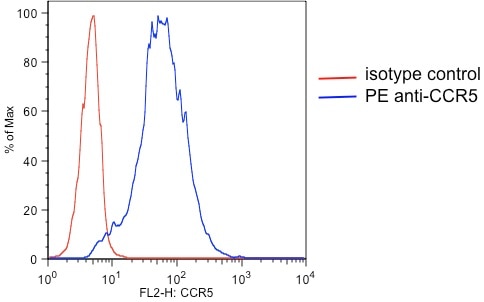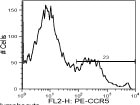Human/Mouse/Rat CCR5 PE-conjugated Antibody Summary
Applications
Please Note: Optimal dilutions should be determined by each laboratory for each application. General Protocols are available in the Technical Information section on our website.
Scientific Data
 View Larger
View Larger
Detection of CCR5 in Human PBMCs by Flow Cytometry. Human peripheral blood mononuclear cells (PBMCs) were stained with Mouse Anti-Human CD3e Alexa Fluor® 405-conjugated Monoclonal Antibody (Catalog # FAB100V) and either (A) Mouse Anti-Human/Mouse/Rat CCR5 PE-conjugated Monoclonal Antibody (Catalog # FAB1802P) or (B) Mouse IgG1Phycoerythrin Isotype Control (Catalog # IC002P). View our protocol for Staining Membrane-associated Proteins.
 View Larger
View Larger
Detection of CCR5 in Mouse Splenocytes by Flow Cytometry. Mouse splenocytes treated with anti-CD3, anti-CD28, 5 ng/mL Recombinant Mouse IL-12 (Catalog # 419-ML) and 10 µg/mL Goat Anti-Mouse IL-4 Polyclonal Antibody (Catalog # AB-404-NA) for 3 days to induce Th1 development were stained with Mouse Anti-Human/Mouse/Rat CCR5 PE-conjugated Monoclonal Antibody (Catalog # FAB1802P, filled histogram) or isotype control antibody (Catalog # IC002P, open histogram). View our protocol for Staining Membrane-associated Proteins.
 View Larger
View Larger
Detection of CCR5 in Rat Splenocytes by Flow Cytometry. Rat splenocytes were stained with Mouse Anti-Human/Mouse/Rat CCR5 PE-conjugated Monoclonal Antibody (Catalog # FAB1802P, filled histogram) or isotype control antibody (Catalog # IC002P, open histogram). View our protocol for Staining Membrane-associated Proteins.
Reconstitution Calculator
Preparation and Storage
- 12 months from date of receipt, 2 to 8 °C as supplied.
Background: CCR5
CCR5 is a G protein-linked seven transmembrane domain chemokine receptor. CCR5 serves as a receptor for several chemokines including MIP-1 alpha, MIP-1 beta, MCP-2, and RANTES. It also functions as a coreceptor for Macrophage Tropic HIV-1 infection.
Product Datasheets
Citations for Human/Mouse/Rat CCR5 PE-conjugated Antibody
R&D Systems personnel manually curate a database that contains references using R&D Systems products. The data collected includes not only links to publications in PubMed, but also provides information about sample types, species, and experimental conditions.
8
Citations: Showing 1 - 8
Filter your results:
Filter by:
-
A method for conducting suppression assays using small numbers of tissue-isolated regulatory T cells
Authors: Stephen T. Ward, Ka-Kit Li, Stuart M. Curbishley
MethodsX
-
CXCR4 expression on pathogenic T cells facilitates their bone marrow infiltration in a mouse model of aplastic anemia.
Authors: Arieta Kuksin C, Gonzalez-Perez G, Minter L
Blood, 2015-02-03;125(13):2087-94.
Species: Mouse
Sample Types: Whole Cells
Applications: Flow Cytometry -
Effector Vgamma9Vdelta2 T cells dominate the human fetal gammadelta T-cell repertoire.
Authors: Dimova T, Brouwer M, Gosselin F, Tassignon J, Leo O, Donner C, Marchant A, Vermijlen D
Proc Natl Acad Sci U S A, 2015-01-23;112(6):E556-65.
Species: Human
Sample Types: Whole Cells
Applications: Flow Cytometry -
Distinct roles for CCR4 and CXCR3 in the recruitment and positioning of regulatory T cells in the inflamed human liver.
Authors: Oo YH, Weston CJ, Lalor PF, Curbishley SM, Withers DR, Reynolds GM, Shetty S, Harki J, Shaw JC, Eksteen B, Hubscher SG, Walker LS, Adams DH
J. Immunol., 2010-02-17;184(6):2886-98.
Species: Human
Sample Types: Whole Cells
Applications: Flow Cytometry -
CD56highCD16-CD62L- NK cells accumulate in allergic contact dermatitis and contribute to the expression of allergic responses.
Authors: Carbone T, Nasorri F, Pennino D
J. Immunol., 2009-12-11;184(2):1102-10.
Species: Human
Sample Types: Whole Cells
Applications: Flow Cytometry -
Lactoferrin, a major defense protein of innate immunity, is a novel maturation factor for human dendritic cells.
Authors: Spadaro M, Caorsi C, Ceruti P, Varadhachary A, Forni G, Pericle F, Giovarelli M
FASEB J., 2008-03-25;22(8):2747-57.
Species: Human
Sample Types: Whole Cells
Applications: Flow Cytometry -
Systemic and local characterization of regulatory T cells in a chronic fungal infection in humans.
Authors: Cavassani KA, Campanelli AP, Moreira AP, Vancim JO, Vitali LH, Mamede RC, Martinez R, Silva JS
J. Immunol., 2006-11-01;177(9):5811-8.
Species: Human
Sample Types: Whole Cells
Applications: Flow Cytometry -
Endogenously expressed nef uncouples cytokine and chemokine production from membrane phenotypic maturation in dendritic cells.
Authors: Messmer D, Jacque JM, Santisteban C, Bristow C, Han SY, Villamide-Herrera L, Mehlhop E, Marx PA, Steinman RM, Gettie A, Pope M
J. Immunol., 2002-10-15;169(8):4172-82.
Species: Human, Primate - Macaca mulatta (Rhesus Macaque)
Sample Types: Whole Cells
Applications: Flow Cytometry
FAQs
No product specific FAQs exist for this product, however you may
View all Antibody FAQsReviews for Human/Mouse/Rat CCR5 PE-conjugated Antibody
Average Rating: 4 (Based on 2 Reviews)
Have you used Human/Mouse/Rat CCR5 PE-conjugated Antibody?
Submit a review and receive an Amazon gift card.
$25/€18/£15/$25CAN/¥75 Yuan/¥2500 Yen for a review with an image
$10/€7/£6/$10 CAD/¥70 Yuan/¥1110 Yen for a review without an image
Filter by:
Human CCR5-transfected MOLT4 cells were stained with either a PE-conjugated isotype control or the anti-CCR5 antibody. Staining was performed at room temperature for 10 minutes using the dilution and buffers stated above.
Specificity: Reasonably specific
Sensitivity: Reasonably sensitive
Buffer: PBS with 2.5% Calf Serum
Dilution: 1/10



